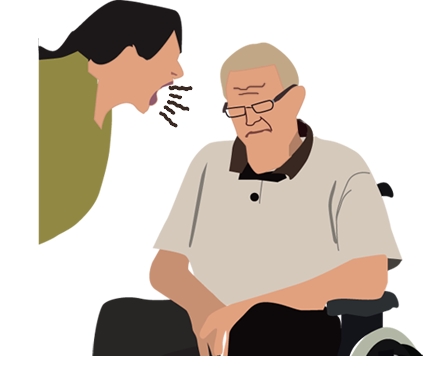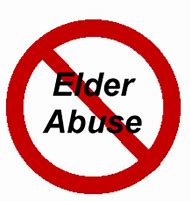Grandparents Need Love Not Bruises
Recognizing and Preventing Elder Abuse

No one wants to admit our elders are abused, neglected and exploited. It’s much like hushing up about child or domestic abuse. Many think if it’s not spoken about, it doesn’t occur.
But it does.
According to the Centers for Disease Control and Prevention (CDC), abuse, including neglect and exploitation, happens to 1 in 10 people aged 60 and older who live at home. Between 2002-2016, more than 643,000 older adults were treated in the emergency department for nonfatal assaults and over 19,000 homicides occurred.
Keep in mind these numbers are low. The National Council on Aging reports that only one out of every 14 cases of elder abuse are ever reported. These numbers only reflect the abuse cases that show up in the ER. Many cases are never reported because elders are ashamed, afraid or unable to tell family, friends or police about the violence. They fear reporting the crime will result in retaliation.
Many times, elders also remain silent because they lack cognitive skills or the physical ability to report it. Others care deeply about the person abusing them and don’t want them to get into trouble. Many are dependent on the care given by the abuser.
Experts also report
- 1 in 20 older adults indicate some form of perceived financial mistreatment occurring in the recent past
- In almost 60 percent of elder abuse and neglect incidents, the perpetrator is a family member. Two-thirds of perpetrators are adult children or spouses.
- 7-10 percent of the elderly suffered from at least one episode of abuse within the past year.
What is Elder Abuse
All 50 states have passed some form of elder abuse protection laws. These laws and definitions vary considerably by state.
Elder abuse is broadly defined as an intentional act or failure to act that causes or creates a risk of harm to an older adult (60+). The abuse comes from a caregiver or a person trusted by the elderly adult.
Learning these 7 most common types of elder abuse can help you recognize when it is happening and how to avoid it.
Neglect: Is one of the most common forms of elder abuse. Unfortunately, it is usually committed by a close family member. It generally involves deprivation and failure to meet an older adult’s basic needs such as food, water, shelter, clothing, hygiene, and essential medical care. This shows up in rapid weight loss, unsanitary or hazardous living conditions, improper attire, dehydration or preventable illnesses. A common example: Setting a plate in front of an elder who is unable to feed him/herself.
Physical: When an elder experiences illness, pain, injury, functional impairment, distress, or death as a result of the intentional use of force. This includes hostile acts such as hitting, kicking, pushing, slapping, burning and restraining by physical and chemical means. Recognize this by seeing visible marks, including bruises, cuts or new mobility limitations.
Sexual: Non-consensual sexual contact of any kind, including harassment. It is also a crime that is difficult to identify and discuss.
Financial Exploitation: The illegal, unauthorized, or improper use of an elder’s money, benefits, belongings, property or assets. For instance, a sudden change in power of attorney or missing bank account statements and unexplainable transactions. Financial neglect occurs when the elder’s financial responsibilities like paying the mortgage or rent, utility bills, medical bills, property taxes, etc. are ignored and bills are not paid. A good indicator is if the caregiver has many new purchases and claims Mom said I could buy these items as presents from her. However, Mom is unaware of the date or time and answers ‘yes’ to every question.
Emotional/Psychological: Verbal or nonverbal behaviors inflecting anguish, mental pain, fear or distress. These include: humiliation, name-calling, repeated fear-inducing language, disrespect, verbal and non-verbal threats, harassment, and geographic or interpersonal isolation. Keeping someone from seeing close friends and relatives is also a sign of emotional abuse. Another possible sign is the caregiver constantly saying, “they’re resting” when you stop by.
Abandonment: Desertion of a vulnerable adult by anyone who assumed the responsibility for care or custody of that person. Elderly persons in need of supervision can accidentally hurt themselves and cause preventable accidents. Abandonment is often thought of as long periods of time. However, abandonment here is any amount of time elders are at risk when left alone. Would you leave an infant or toddler alone for any length of time?
Self-Neglect: Self-neglect that takes place under institutionalized supervision is a form of abuse. Self-neglect in one’s home starts very gradually. Depression among the elderly may be self-neglect. It can start with a mild fall where one cannot completely get back to a normal routine or begin with deteriorating health. It can also begin with the loss of a loved one or a pet. It is not just one day the elder has neglected themselves and stopped taking out the trash, cleaning or cooking. It happens over time. Depending on when the self-neglect is discovered determines what the next steps of care are. If a person lives alone but cannot feed and clean themselves, they will require supervision. Elder self-neglect, according to studies, is higher amongst elders lacking family support-those known as orphaned elders.
Warning Signs
Abused elderly often suffer in silence.
Start to question what is going on if you notice changes in the person’s personality and/or behavior. Remember, it is not your role to confirm the abuse, only to alert proper authorities of your suspicion of abuse.
Click here for state specific contact information. What If I Suspect Abuse, Neglect, or Exploitation? | ACL Administration for Community Living
- Unexplained bruises, broken bones, sprains, burns, pressure marks, cuts, or scars
- Bruises around breasts or the genital area; sexually transmitted diseases or pain upon urination or bowel movements
- Messy appearance with unwashed hair and dirty clothes
- Displays signs of trauma, like rocking back and forth
- Bedsores and unusual weight loss
- Broken eyeglasses/frames
- Physical signs of being restrained or punished
- Unexplained withdrawal from activities he/she enjoys
- Sudden financial changes like an eviction notice for unpaid rent, notice of late mortgage or home eviction or many new purchases for the caregiver
- Unpaid bills despite adequate financial resources
- Belittling, threats, and other uses of power and control by spouses
- If elder is trying to speak but looks at caregiver and abruptly quits talking
- Frequent loud arguments, strained and tense relationships between the caregiver and the elderly person or the senior seems timid around the caregiver
- Lacks medical aids like glasses, walker, dentures, hearing aids or medications

Ways to Prevent Elder Abuse
- Check-in on older adults who may have few family members or friends. Be alert. Look for clues of abuse. Is there forcible restraint and forced feeding? Does the person have a heightened sense of fear, anxiety or other results of current trauma? Remember, this can be challenging when a person suffers from dementia or is otherwise unable to communicate clearly.
- Talk to the older adult’s support system or family who may live in a different geographical area. Families usually have the ability to intervene, especially if the caregiver is hired. They can fire them and remove them from the person’s home. They can also report the incident(s) to the police.
- Learn how elder abuse signs differ from the normal aging process.
- Report abuse or suspected abuse to adult protective services, a trusted doctor or nurse or the police. Elder abuse can be a criminal offense. Making a police report creates a paper trail and will hopefully lead to an investigation. Click here for state specific information. NCEA – State (acl.gov)
- Consult with an elder law attorney. While elder abuse is often a crime, elder abuse can be the basis for a civil lawsuit against the perpetrator and/or facility.
- Offer to help and support over-burdened caregivers
Effects of Abuse
Elder abuse frequently leads to early death. It harms the person’s physical and psychological health, destroys social and family ties and can cause devastating long-term financial loss.
Any mistreatment leaves the abused person feeling depressed and fearful. Some victims feel the abuse is his or her own fault.
Agencies generally suggest support groups and counseling to help an abused person heal emotional wounds. The practicality of this for elderly abused persons is unknown.
What is known is that once an abused elder starts to receive care, kindness, hygiene and more, they begin to perk up, especially if there are memory issues. They soon are living in the present again and they begin to calm down.
Note to Caregivers from Denise
Caregiving can be difficult and often stressful. You may need to be “on the clock” 24 hours a day, 7 days a week doing everything from preparing meals, doing laundry, cleaning the home, scheduling and driving to medical appointments, paying bills, providing nursing care, etc.
You may have had to put your career and social life on the back burner to care for someone who shows little signs of improvement.
The demands of caretaking over time can take a toll. To ensure you do not become neglectful or abusive to the one you are caring for, you must make time to rest and care for your own needs.
Do not be afraid to ask for help, even if it’s just for a few hours.

If you need assistance with the one you are caring for, or for yourself, reach out to us. We have 30+ years working with caregivers and those who need care. We are here to help.
-Denise-
More Information
Fast Facts: Preventing Elder Abuse |Violence Prevention|Injury Center|CDC
Elder Abuse Surveillance: Uniform Definitions and Recommended Data Elements (cdc.gov)
What is Elder Abuse? | ACL Administration for Community Living
Elderly Abuse Statistics: It’s More Common Than You Think! – RespectCareGivers
©July 2022 Craft LifeStyle Management.
All Rights Reserved.
